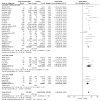Pregestational Diabetes Mellitus and Adverse Perinatal Outcomes: A Systematic Review and Meta-Analysis
- PMID: 40649178
- PMCID: PMC12251443
- DOI: 10.3390/jcm14134789
Pregestational Diabetes Mellitus and Adverse Perinatal Outcomes: A Systematic Review and Meta-Analysis
Abstract
Background/Objectives: As the incidence of diabetes mellitus (DM) is increasing rapidly worldwide, it is anticipated that an increasing number of women will enter pregnancy with pregestational diabetes mellitus (PGDM) in the future. Compelling evidence suggests that hyperglycemia in pregnancy is related to multiple adverse perinatal outcomes. This systematic review and meta-analysis aims to assess and quantify the association of PGDM with a range of adverse perinatal outcomes, providing a comprehensive understanding of its impact on pregnancy. Methods: The data sources of this systematic review and meta-analysis were Medline/PubMed, Scopus and Cochrane Library (January 1999 to August 2023), complemented by hand-searching for additional references. Observational studies reporting perinatal outcomes of pregnancies with PGDM diagnosed before pregnancy versus control pregnancies were eligible for inclusion. A systematic review and meta-analysis were conducted as per the PRISMA guidelines. Pooled estimate odds ratios (ORs) with 95% confidence intervals (CIs) were calculated to determine the risk of adverse pregnancy outcomes between PGDM and control pregnancies. Results: The systematic search of the literature yielded 81 observational studies meeting inclusion criteria and in total, 137,237,640 pregnancies were included in the analysis. A total of 19 adverse perinatal outcomes were assessed, revealing a significant association with PGDM. In pregnancies with PGDM there was an increased risk of adverse perinatal outcomes, including gestational hypertension (OR 3.16, 95% CI 2.65-3.77), preeclampsia (OR 4.46, 95% CI 3.94-5.05), preterm delivery (OR 3.46, 95% CI 3.06-3.91), cesarean delivery (OR 3.12, 95% CI 2.81-3.47), induction of labor (OR 2.92, 95% CI 2.35-3.63), macrosomia (OR 2.23, 95% CI 1.76-2.83), LGA neonates (OR 3.95, 95% CI 3.47-4.49), low 5-min Apgar score (OR 2.49, 95% CI 2.07-2.99), shoulder dystocia (OR 3.05, 95% CI 2.07-4.50), birth trauma (OR 1.40, 95% CI 1.22-1.62), polyhydramnios (OR 5.06, 95% CI 4.33-5.91), oligohydramnios (OR 1.61, 95% CI 1.19-2.17), neonatal hyperbilirubinemia (OR 3.45, 95% CI 2.51-4.74), neonatal hypoglycemia (OR 19.19, 95% CI 2.78-132.61), neonatal intensive care unit (NICU) admission (OR 4.54, 95% CI 3.87-5.34), congenital malformations (OR 2.44, 95% CI 1.96-3.04), stillbirth (OR 2.87, 95% CI 2.27-3.63) and perinatal mortality (OR 2.94, 95% CI 2.18-3.98). Subgroup analyses indicated a higher risk of neonatal hypoglycemia, stillbirth and perinatal mortality in T1DM pregnancies compared with T2DM pregnancies. Conclusions: This study provides a robust synthesis of evidence underlying the strong association between PGDM and several adverse perinatal outcomes. Early detection, optimal glycemic control during the periconceptional and pregnancy periods, and proper antenatal care are critical to mitigate these risks.
Keywords: adverse outcomes; complications; maternal; neonatal; preexisting diabetes; pregnancy; type 1 diabetes; type 2 diabetes.
Conflict of interest statement
The authors declare no conflicts of interest.
Figures





















References
-
- World Health Organisation . Global Report on Diabetes. World Health Organisation; Lyon, France: 2016.
-
- Sun H., Saeedi P., Karuranga S., Pinkepank M., Ogurtsova K., Duncan B.B., Stein C., Basit A., Chan J.C., Mbanya J.C., et al. IDF Diabetes Atlas: Global, regional and country-level diabetes prevalence estimates for 2021 and projections for 2045. Diabetes Res. Clin. Pract. 2022;183:109119. doi: 10.1016/j.diabres.2021.109119. - DOI - PMC - PubMed
Publication types
LinkOut - more resources
Full Text Sources
Research Materials

